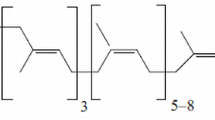Summary
-
1.
The preparation and properties of125I-labelled tetanus toxin are described.
-
2.
After intravenous injection there is a short phase when the labelled toxin is rapidly removed from the blood plasma. This initial period is followed by a slow second phase of decay which has a longer duration. The first phase in very pronounced in rabbits, but not in rats.
Unlabelled toxin is removed equally fast from rabbit plasma, as has been revealed by measuring the immunological reactivity (so-called “junction test”) and toxicity.
-
3.
Thirty minutes after i.v. administration torabbits about 2/3 of the radioactive label are found in the liver. The highest concentration is attained in the spleen. 24 hours later, the bulk of the label has been excreted in the urine and faeces, which indicates catabolism of the toxin. In therat, the concentration in the liver is much less prominent, and the excretion of the label is slower. In both species, the central nervous system does not accumulate more than just measurable quantities of the label, even if the animals are given large toxic doses.
-
4.
After injection into the left gastrocnemius muscle of the rat, the labelled tetanus toxin is absorbed very slowly from the site of administration. It is taken up by the corresponding N. ischiadicus and the lumbar region of the spinal cord. The injection of toxin into the anterior leg leads to concentration of radioactivity in the cervical area of the medulla. The arrival of the label in the spinal cord coincides approximately with the appearance of local tetanus.
Sectioning of the N. ischiadicus prevents the appearance of the local tetanus of the lower extremity. The enrichment of the toxin in the lumbar cord is prevented in operated, but not in sham-operated rats.
-
5.
When the spinal cord was subdivided into four sectors, the label was found to be greatly concentrated in the ipsilateral ventral sector of the segment corresponding with the injected extremity. This indicates transport into the ventral roots.
-
6.
131I-labelled tetanus antitoxin also disappears very slowly from the rat gastrocnemius. In contrast to labelled tetanus toxin, however, it is not concentrated in the spinal cord.
Similar content being viewed by others
Literatur
Acheson, G. H., Ratnoff, O. D., Schoenbach, E. B.: The localized action on the spinal cord of intramuscularly injected tetanus toxin. J. exp. Med.75, 465–480 (1942).
Behring, B. v.: Einführung in die Lehre von der Bekämpfung der Infektionskrankheiten, 8. 228 (zit. nach Wright). Berlin: Hirschwald 1912.
Bizzini, B., Turpin, A., Raynaud, M.: Production et purification de la toxine tetanique. Ann. Inst. Pasteur116, 686–712 (1969).
Fedinec, A. A.: Studies on the mode of the spread of tetanus toxin in experimental animal. Proc. Second Int. Pharmacol. Meeting9, 125–138 (1965).
—: Absorption and distribution of tetanus toxin in experimental animals. In: Principles on tetanus, pp. 168–175. (Hrsg.: L. Eckmann). Bern: Huber 1967.
—, Matzke, H. A.: The relationship of toxin and antitoxin injection site to tetanus development in the rat. J. exp. Med.110, 1023–1040 (1959).
Habermann, B.: Ein neues Prinzip zur quantitativen Bestimmung hochmolekularer Antigene (Verknüpfungstest) und seine Anwendung auf Tetanustoxin, Serumalbumin und Ovalbumin. Z. klin. Chem. u. klin. Biochem.8, 51–55 (1970).
—, Räker, K. O., Zeuner, G.: Solid-phase-Radioimmunassay und Blutspiegel von Staphylokokken-α-Toxin. Naunyn-Schmiedebergs Arch. Pharmak. exp. Path.262, 165–182 (1969).
Kirilenko, O. A., Minervin, S. M., Rozanov, A. Y.: Fate of labeled tetanus toxin in animal body. Zh. Mikrobiol. (Mosk.)47, 123 (1964).
Kryzhanovskyi, G. N.: On the action of tetanus toxin as a neurotropic agent. Proc. Second Int. Pharmacol. Meeting9, 105–113 (1965).
—: The neural pathway of toxin. In: Principles on tetanus, pp. 155–168. (Hrsg.: L. Eckmann). Bern: Huber 1967.
Lamanna, O., Carr, C. J.: The botulinal, tetanal, and enterostaphylococcal toxins: a review. Clin. Pharmacol.8, 286–332 (1967).
McConahey, P. J., Dixon, F. J.: A method of trace iodination of proteins for immunologic studies. Int. Arch. Allergy29, 185–189 (1966).
Tateno, I.: Incubation period and the initial symptoms of tetanus: a clinical assessment of the problem of the passage of tetanus toxin to the central nervous system. Jap. J. exp. Med.33, 149–158 (1963).
Wright, G. P.: The neurotoxins of elostridium botulinum and clostridium tetani. Pharmacol. Rev.7, 413–465 (1955).
Zacks, S. I., Sheff, M. F.: Tetanus toxin: fine structure localization of binding sites in striated muscle. Science159, 643–644 (1968).
Author information
Authors and Affiliations
Rights and permissions
About this article
Cite this article
Habermann, E. Pharmakokinetische Besonderheiten des Tetanustoxins und ihre Beziehungen zur Pathogenese des lokalen bzw. generalisierten Tetanus. Naunyn-Schmiedebergs Arch. Pharmak. 267, 1–19 (1970). https://doi.org/10.1007/BF00997110
Received:
Issue Date:
DOI: https://doi.org/10.1007/BF00997110




